|
Historic
Context
 The
first half of the 19th century ushered in an era of expansive and innovative
change within America. Beginning with the early settlements, it was commonplace
to have graveyards embedded in the hustle and bustle of a town, in or
around a common area or beside a house of worship. As the Industrial Revolution
gathered momentum in the United States and settlements grew to towns and
then to cities, burial grounds rarely remained sacred. If the city needed
the land for industrialization purposes, property changed hands or vandalism
could no longer be avoided in a certain location, then the graveyards
were covered up, moved or simply destroyed. Graves were temporary and
dug up when a person's paid lease on a plot had run out (usually around
6 or so years). Death in early America was not associated with a pious
and emotional "celebration of life," but rather with morbidity
and depressing "means to the end." The
first half of the 19th century ushered in an era of expansive and innovative
change within America. Beginning with the early settlements, it was commonplace
to have graveyards embedded in the hustle and bustle of a town, in or
around a common area or beside a house of worship. As the Industrial Revolution
gathered momentum in the United States and settlements grew to towns and
then to cities, burial grounds rarely remained sacred. If the city needed
the land for industrialization purposes, property changed hands or vandalism
could no longer be avoided in a certain location, then the graveyards
were covered up, moved or simply destroyed. Graves were temporary and
dug up when a person's paid lease on a plot had run out (usually around
6 or so years). Death in early America was not associated with a pious
and emotional "celebration of life," but rather with morbidity
and depressing "means to the end."
These unkempt graveyards
were scattered with bits of bone, wreathed in a wretched stench, and representative
of a hopeless sense of finality for the living members of the community.
Timothy
Dwight (1752-1817), president of Yale College and the author of Travels
in New England and New York discussed the pitiful appearance of a
graveyard in Guilford, Connecticut by stating:
"…the
memorials of the dead are presented to the mind in circumstances so
gross and indicative of so little respect in the living as to eradicate
every emotion naturally excited by the remembrance of the deceased…
Nor is it unreasonable to suppose that the proximity of these sepulchral
fields to human habitation is injurious to health." (French 73)
 As
populations grew, the health issue became more urgent. New York City went
so far as to prohibit "intramural" (inner city) burial grounds
in order to combat problems associated with the compromised health of
its surrounding inhabitants. The 1822 yellow fever epidemic of New York
City was not enough to instill fear among the Bostonians and in that same
year, neighborhood churches asked the city if they could begin interring
bodies in underground cellar vaults because of the overcrowded state of
present graveyards. America was ready for a new solution- a place whereby
the dead could rest in dignified peace and the living could go to escape
hectic daily existence and to pay their respects comfortably, not disturbed
or terrified by the grotesque physicality of death. As
populations grew, the health issue became more urgent. New York City went
so far as to prohibit "intramural" (inner city) burial grounds
in order to combat problems associated with the compromised health of
its surrounding inhabitants. The 1822 yellow fever epidemic of New York
City was not enough to instill fear among the Bostonians and in that same
year, neighborhood churches asked the city if they could begin interring
bodies in underground cellar vaults because of the overcrowded state of
present graveyards. America was ready for a new solution- a place whereby
the dead could rest in dignified peace and the living could go to escape
hectic daily existence and to pay their respects comfortably, not disturbed
or terrified by the grotesque physicality of death.
First
Experiments
 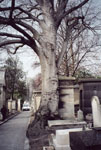 In
Europe, the government had more power over the rule and regulation of
graveyards and the grand Père
Lachaise cemetery on the outskirts of Paris was established in 1804
to battle similar problems concerning overcrowded sites and hygiene, but
to do so in an "ornamental" way. The two images to the left
and right show the Parisian site. The idea was to create a place or "sanctuary
of the dead" which was to be "picturesque," "romantic,"
and inviting by way of lush green hillsides and winding paths which led
visitors around the space among eclectic monuments, belonging both to
commoners and to nobility or celebrities. Americans traveling to France
were now mesmerized by this style of graveyard. In
Europe, the government had more power over the rule and regulation of
graveyards and the grand Père
Lachaise cemetery on the outskirts of Paris was established in 1804
to battle similar problems concerning overcrowded sites and hygiene, but
to do so in an "ornamental" way. The two images to the left
and right show the Parisian site. The idea was to create a place or "sanctuary
of the dead" which was to be "picturesque," "romantic,"
and inviting by way of lush green hillsides and winding paths which led
visitors around the space among eclectic monuments, belonging both to
commoners and to nobility or celebrities. Americans traveling to France
were now mesmerized by this style of graveyard.
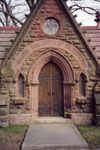 The
Romanticism of the era emphasized the poetry in the delicate balance between
life and death. Death was no longer something to fear- it became a beautiful
and mystical metamorphosis. The Greek word cemetery, "sleeping
chamber," was embraced by this budding urbanized country, discovering
a new cultural institution. The rural cemetery's "safe haven"
of untouched, serene and picturesque nature honored and revered those
who had gone before. Monuments took the form of Gothic chapels, Grecian
urns which were "all the rage" during this time of Greek Revival
and also included Egyptian symbols of death- the sphinx, upside down lotus
flower and obelisk. The
Romanticism of the era emphasized the poetry in the delicate balance between
life and death. Death was no longer something to fear- it became a beautiful
and mystical metamorphosis. The Greek word cemetery, "sleeping
chamber," was embraced by this budding urbanized country, discovering
a new cultural institution. The rural cemetery's "safe haven"
of untouched, serene and picturesque nature honored and revered those
who had gone before. Monuments took the form of Gothic chapels, Grecian
urns which were "all the rage" during this time of Greek Revival
and also included Egyptian symbols of death- the sphinx, upside down lotus
flower and obelisk.
Mount
Auburn Cemetery in Cambridge, Massachusetts, inspired by Père
Lachaise was the first and greatest of the American rural cemeteries.
A public institution, anyone who liked could buy a plot; there were even
designated areas for single graves, for those who could not afford an
entire plot. The urban population of Boston was encouraged to come stroll,
soak in the scenery (of a cultivated and verdant variety unavailable in
the crowded sooty city), and benefit from the lessons and cultural enrichment
the site offered. Transportation was becoming more developed so people
could easily travel in small or large groups by way of street car or carriage
to reach their "pastoral weekend destination." In fact, the
popularity of these places - which rapidly became unseemly bustle and
crowdedness, defeating the reflective and Romantic purpose of the rural
cemetery - was the driving force behind the development of the great public
urban parks (starting with Olmstead
in New York City, ca.1860). Clearly, there was a need for a respite from
the new industrial urban life, particularly in those who could not afford
a country home; for many years, this need was fulfilled solely by Mount
Auburn and by its imitators.
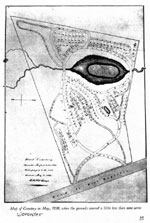 Death
was now less of a "communal event," and evolved into a more
intimate family affair. Prior to the introduction of the rural cemetery
as shown here for Worcester, the church, graveyard and the person's house
were roughly within 1,000 feet of each other and people simply walked
from one place to another. Now, the dead could be in the company of "common
friends" in a fenced-in and well-maintained plot among the densely
packed shrubs and horticulture of the rural setting. People could buy
into these newly established sites run mostly by private nonprofit corporations,
create a family plot and maintain it however they so pleased within the
boundaries created by the board of directors. Death
was now less of a "communal event," and evolved into a more
intimate family affair. Prior to the introduction of the rural cemetery
as shown here for Worcester, the church, graveyard and the person's house
were roughly within 1,000 feet of each other and people simply walked
from one place to another. Now, the dead could be in the company of "common
friends" in a fenced-in and well-maintained plot among the densely
packed shrubs and horticulture of the rural setting. People could buy
into these newly established sites run mostly by private nonprofit corporations,
create a family plot and maintain it however they so pleased within the
boundaries created by the board of directors.
Philosophical
Ideals of the Beautiful, Picturesque, Sublime
 The
philosophical underpinning of the movement of the United States grew from
17th-century English roots. English theorists divided the aesthetics of
natural landscape into three categories: the "Beautiful," the
"Picturesque," and the "Sublime";
the rural cemetery took the form of the Picturesque. These cemeteries
were the "first planned landscapes open to the public in America,"
(Sloane 56) and contributed to the popularization of landscape architecture
in general, and of the Picturesque in particular. The
philosophical underpinning of the movement of the United States grew from
17th-century English roots. English theorists divided the aesthetics of
natural landscape into three categories: the "Beautiful," the
"Picturesque," and the "Sublime";
the rural cemetery took the form of the Picturesque. These cemeteries
were the "first planned landscapes open to the public in America,"
(Sloane 56) and contributed to the popularization of landscape architecture
in general, and of the Picturesque in particular.
The Beautiful style
represents nature subordinated to civilization; the focus here is on pure
geometry, idealized harmony and supreme order. Le
Nôtre's 17th century gardens at Versailles are a good (albeit
extravagant) example of this style. Close pruning, mathematically precise
beds and hedges, straight paths, topiary trees, and other blatantly artificial
forms are imposed upon the landscape. These elements emphasize the human
concepts behind the design and the human control over the environment.
In the context of 19th century America, this sort of formal garden or
landscape could be seen as a physical embodiment of Neo-Classical and
Enlightenment rationalism.
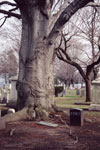 The
opposite of the Beautiful is the Sublime: this style (or rather, anti-style)
refers to untamed wilderness. Overwhelmingly powerful nature, great and
awesome and independent of humanity, conveys (at least in this worldview)
the idea of civilization's transience and impotence. Romantic thinkers
were innovative valuing the Sublime as an ideal, closer than the civilized
setting to God's might and perfection; however, the persistence of the
old "Christian ambivalence" (Upton 113) of colonists towards
nature (with its connotations of savagery and heathenism) necessitated
a modification of the Sublime's natural energy, something more gentle
and easier for the modern Westerner to digest. Thus, we have the Picturesque. The
opposite of the Beautiful is the Sublime: this style (or rather, anti-style)
refers to untamed wilderness. Overwhelmingly powerful nature, great and
awesome and independent of humanity, conveys (at least in this worldview)
the idea of civilization's transience and impotence. Romantic thinkers
were innovative valuing the Sublime as an ideal, closer than the civilized
setting to God's might and perfection; however, the persistence of the
old "Christian ambivalence" (Upton 113) of colonists towards
nature (with its connotations of savagery and heathenism) necessitated
a modification of the Sublime's natural energy, something more gentle
and easier for the modern Westerner to digest. Thus, we have the Picturesque.
 The
Picturesque aims for a balance between civilization and nature, between
the Beautiful and the Sublime: human structures and design are present
but should not seem to dominate. "The beautiful… is universal
and based on classical rules of line and proportion; the sublime [is]
stimulated by the great, terrifying, overwhelming, or deeply moving; and
the picturesque [is] produced by variety and contrast" (Upton 113).
The landscape gardener such as Andrew
Jackson Downing aimed to "heighten the charms of nature,"
(Downing 29) with strategically placed groves and clearings, artfully
unkempt flora, undulating hills and hollows, and meandering unpaved paths.
None of the symmetry, straight lines, right angles, or perfect circles
of the Beautiful are permitted. However, although the visitor can lose
himself in contemplation of his rustic (or rusticated) surroundings, he
never suffers the anxiety of actually being lost in the woods. The
Picturesque aims for a balance between civilization and nature, between
the Beautiful and the Sublime: human structures and design are present
but should not seem to dominate. "The beautiful… is universal
and based on classical rules of line and proportion; the sublime [is]
stimulated by the great, terrifying, overwhelming, or deeply moving; and
the picturesque [is] produced by variety and contrast" (Upton 113).
The landscape gardener such as Andrew
Jackson Downing aimed to "heighten the charms of nature,"
(Downing 29) with strategically placed groves and clearings, artfully
unkempt flora, undulating hills and hollows, and meandering unpaved paths.
None of the symmetry, straight lines, right angles, or perfect circles
of the Beautiful are permitted. However, although the visitor can lose
himself in contemplation of his rustic (or rusticated) surroundings, he
never suffers the anxiety of actually being lost in the woods.
 Proponents
of the picturesque limit the obvious maintenance of the landscape to the
bare minimum: an attractive dead tree might be allowed to stand and bring
character to a vista; stones may remain mossy and crumbling; wild climbing
vines are to be cultivated and guided, not weeded out. The "sylvan
beauty" (Downing 29-30) of indigenous forms and plant-life
is preferred to contrived and trendy imports (a novel concept for 19th
century America's image-conscious upper and middle classes). That said,
clear evidence of human presence in (and often, ownership of) the environment
is welcomed in the form of "winding walks," "shady bowers,"
and "rustic seats" (Downing) tucked throughout the property.
For buildings in this setting, 19th century Americans favored the Gothic
style; the less Romantic Greek-Revival
houses are most often paired with gardens in the Beautiful style. (Of
course, a house needn't be Gothic Revival to be successfully Picturesque:
Frank Lloyd Wright's Falling
Water house of the early 20th century is an excellent example.) Proponents
of the picturesque limit the obvious maintenance of the landscape to the
bare minimum: an attractive dead tree might be allowed to stand and bring
character to a vista; stones may remain mossy and crumbling; wild climbing
vines are to be cultivated and guided, not weeded out. The "sylvan
beauty" (Downing 29-30) of indigenous forms and plant-life
is preferred to contrived and trendy imports (a novel concept for 19th
century America's image-conscious upper and middle classes). That said,
clear evidence of human presence in (and often, ownership of) the environment
is welcomed in the form of "winding walks," "shady bowers,"
and "rustic seats" (Downing) tucked throughout the property.
For buildings in this setting, 19th century Americans favored the Gothic
style; the less Romantic Greek-Revival
houses are most often paired with gardens in the Beautiful style. (Of
course, a house needn't be Gothic Revival to be successfully Picturesque:
Frank Lloyd Wright's Falling
Water house of the early 20th century is an excellent example.)
"The picturesque
encompassed topographical irregularities… In search of the picturesque,
architects and landscape architects cultivated the genius loci, the
peculiar character of a place from which good design took its cue, and
drew on the visual richness of architectural history to stir viewers'
emotions" (Upton 113).
American
Examples and Worcester's Rural Cemetery
 There
are many reasons for the popular use of the Picturesque in the rural cemeteries.
At this time, the picturesque was a "modern" and "English"
style, and Americans took many cultural and stylistic cues from Europe,
especially England. On the other hand, the new style has also been interpreted
as a rejection of the old Federal formalism (Andrews 103) and of America's
provincial and old-fashioned colonial heritage in favor of a bright and
vibrant future. The 1830s-70s represent a period of explosive population
growth, leaps in technological ability, and economic and cultural optimism. There
are many reasons for the popular use of the Picturesque in the rural cemeteries.
At this time, the picturesque was a "modern" and "English"
style, and Americans took many cultural and stylistic cues from Europe,
especially England. On the other hand, the new style has also been interpreted
as a rejection of the old Federal formalism (Andrews 103) and of America's
provincial and old-fashioned colonial heritage in favor of a bright and
vibrant future. The 1830s-70s represent a period of explosive population
growth, leaps in technological ability, and economic and cultural optimism.
Related to this great
optimism are the growing forces of civic pride, as exemplified by organizations
such as the Worcester Mechanics' Association
founded at this time. As America shed its identity as the feisty and somewhat
backwards stepchild of the great European states, its society began to
appreciate its environment as superior to that of Europe - a "second
Eden" (Upton 114). "Invocation of the land (which included not
only its plants and animals, but also its indigenous people and its 'naturalized'
European colonists) was a patriotic affirmation" (Upton 114). Thus,
the picturesque rural cemeteries (which naturally encourage reflection
upon generations past, sacralizing the nation's history) enabled contemporary
visitors to honor both their country's history and its present and vital
manifestation. Charles Fraser's address dedicating Magnolia Cemetery,
19th November, 1850, explained: "To the dead… in our own beloved
country, we owe, not only the foundations of the great fabric of our liberties,
but those lessons of wisdom, justice and moderation, upon the observance
of which alone can depend its stability" (French 81).
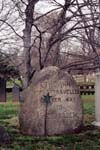 Finally,
these rural cemeteries were perceived to be places of "succor and
[moral and religious] instruction" as phrased by Wilson Flagg in
his 1861 essay Mount Auburn: Its Scenes, Its Beauties, and Its Lessons
(French 79). The many admirers of Mount Auburn were convinced by its melancholic
combination of secluded nature with nostalgic monuments to the deceased
that "a rural cemetery is a school of both religion and philosophy"
(French, 78). The divine in nature and the moral lessons of the past formed
an ideal partnership. Finally,
these rural cemeteries were perceived to be places of "succor and
[moral and religious] instruction" as phrased by Wilson Flagg in
his 1861 essay Mount Auburn: Its Scenes, Its Beauties, and Its Lessons
(French 79). The many admirers of Mount Auburn were convinced by its melancholic
combination of secluded nature with nostalgic monuments to the deceased
that "a rural cemetery is a school of both religion and philosophy"
(French, 78). The divine in nature and the moral lessons of the past formed
an ideal partnership.
Worcester's
Rural Cemetery was proposed at a Lyceum meeting in 1837 as an application
of the idea of Mount Auburn to Worcester. Located over a mile from the
center of town, in what really was a "rural" area in 1838, the
parcel of land - including many charming hills and a scenic pond - was
donated by Daniel Waldo. In 1852, the city accommodated its growing population
by building a public municipal rural cemetery on the other side of town,
Hope Cemetery. The early lay-out, monuments, and landscaping of both are
clearly picturesque; it is only after many years that the vistas have
become visually cluttered with grave-stones. This is an issue eventually
confronted by all the old picturesque rural cemeteries, and historical
landscape in general: preservation of the original form and intent is
rarely possible (Fitch). However, even today, the undulating paths, the
secret nooks and evergreen groves, and the quiet vistas over ponds and
valleys provide a location for the 21st century Worcester resident to
escape the city (visually if not geographically) for a quiet and reflective
afternoon of strolling through nature - and in a way, through the past
as well.
Bibliography
Andrews, Wayne, Architecture,
Ambition and Americans: A Social History of American Architecture.
The Free Press, New York: 1967.
Downing, A. J., Landscape Gardening and Rural Architecture. Dover,
New York: 1991 (orig. 1865).
Fitch, James Marston, Historic Preservation: Curatorial Management
of the Built World - Chapter 13. University Press of Virginia, Charlottesville
and London: 1990.
French, Stanley. "The Cemetery as Cultural Institution: the Establishment
of Mount Auburn and the Rural Cemetery Movement," in Death in
America. Stannard, David E. ed., Philadelphia: University of Pennsylvania
Press, 1975: 44-64.
Sloane, David Charles, "Mount Auburn and the Rural Cemetery Movement"
from The Last Great Necessity. Baltimore: Johns Hopkins University
Press, 1991: 69-91.
Tymeson, Mildred McClary, Rural Retrospect: A Parallel History of Worcester
and Its Rural Cemetery. 1956.
Upton, Dell, Architecture in the United States. Oxford University
Press: 1998.
|

